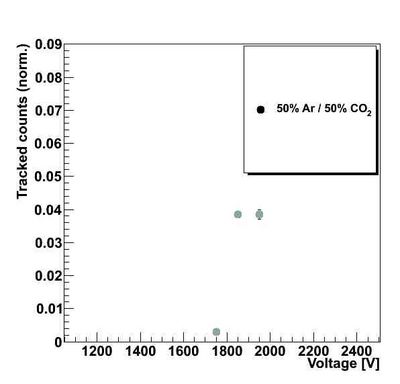ASIC meeting June 2x, 2010
On June 23, we came to the conclusion that our old preamplifier bit the dust. Detailed pictures showing how its performance has changed over the last several months are below. These clearly show that the gain increased by a factor of at least four and that there is substantially more noise.
The following link points to comparisons of cosmic data taken with the old preamplifier several months ago and with the new preamplifier. They clearly show that the signals (for the same gas and voltage settings) are larger with the new preamplifier.
The following plots are taken using the new preamplifier with our FADC range decreased to match
the lower maximum output voltage from the new preamplifier (about 500mV). The old preamplifier
had a higher limit (~1V).
Efficiency Plots for the CDC
The following plot is taken from our NIM article that shows the chamber efficiency as a function of the high voltage setting for various gas mixtures using the old preamplifier. As can be seen, for the optimal gas mixture (around 50/50), the plateau starts at about 2100 V and there is no efficiency below around 1900V.
We are currently in the process of repeating the 50-50 measurements using the new preamplifier. What we see immediately is that the operating point is now about 200V lower than it was before. This is possible because the noise is lower and necessary because the signals are bigger than they were before and the preamplifier will not output signals larger than about 500mV. A low statistics efficiency plot obtained with these new data (new preamp, new fADC range) for channel 7, which had the largest number of tracks going through it is shown here.

